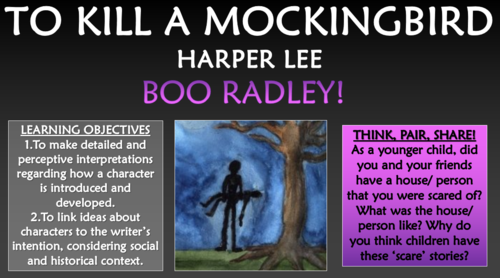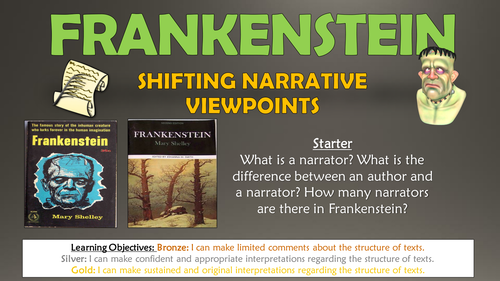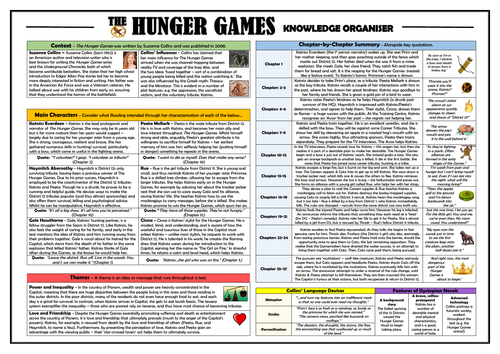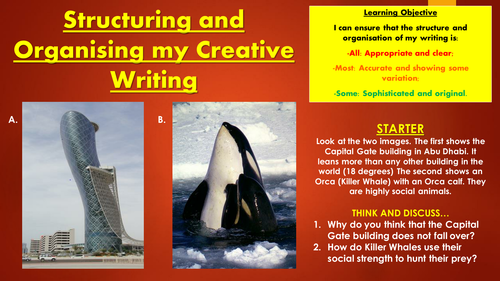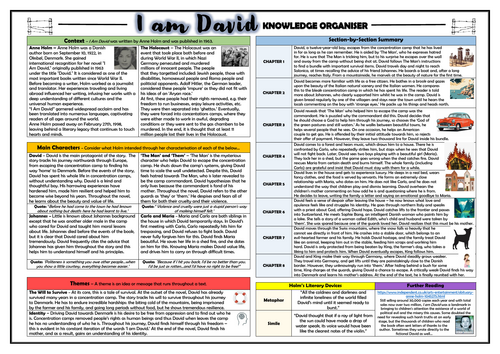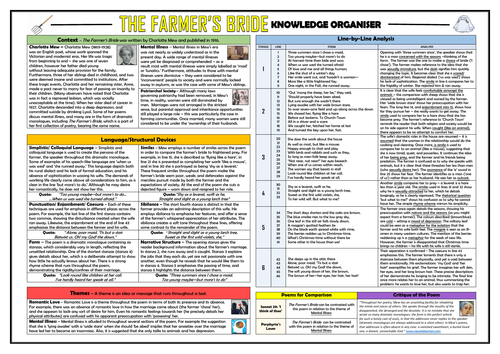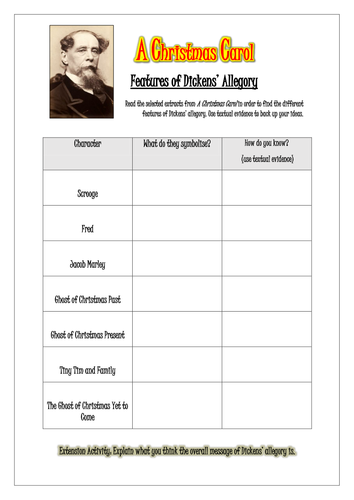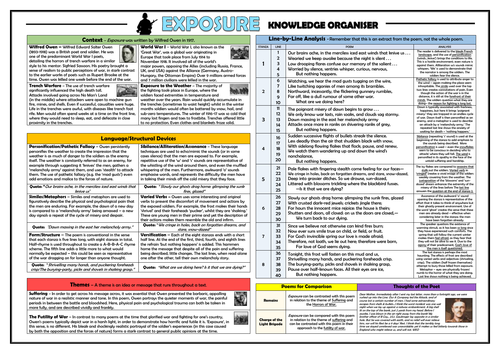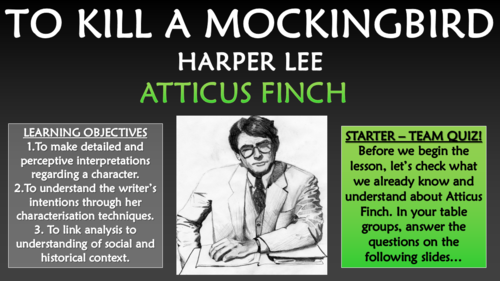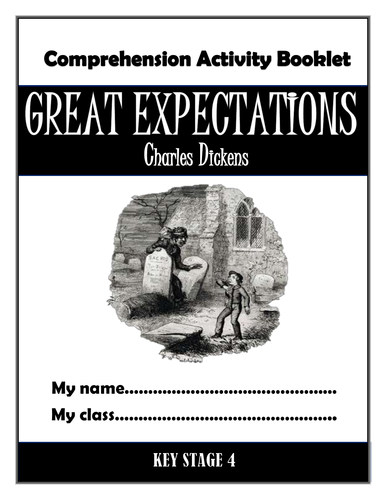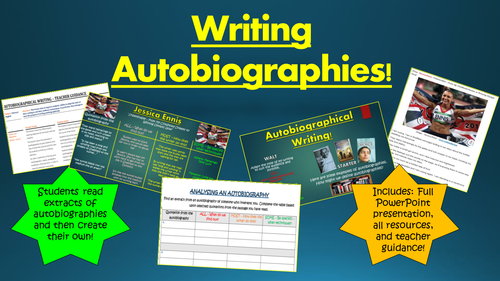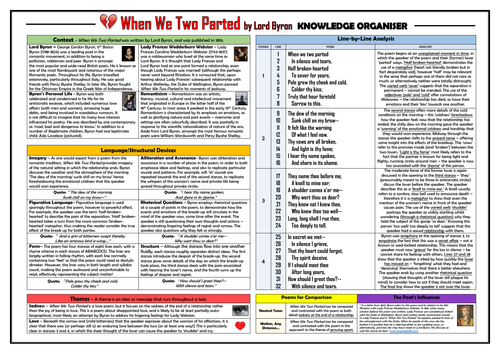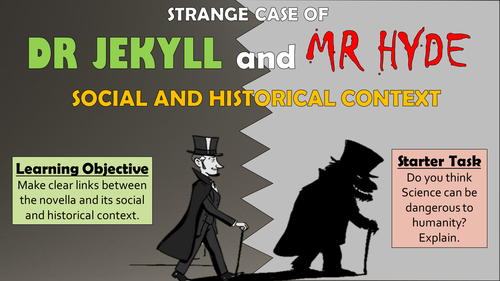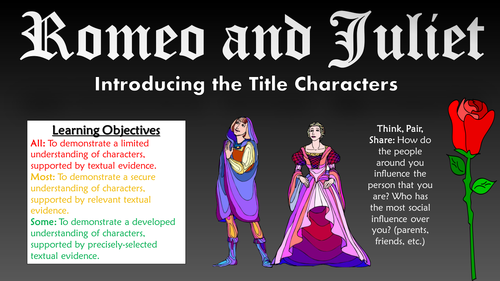
3k+Uploads
1969k+Views
2279k+Downloads
English

Holes - The Warden!
This engaging and informative lesson enables students to understand the character of the Warden from Louis Sachar's 'Holes', making insightful comments about her character based upon her actions, and backing these ideas up with reference to evidence from the text.
The lesson follows a step-by-step learning journey, in which children learn through:
- Reading and understanding the selected extracts to determine the key traits of The Warden's character at different points in the text;
- Noticing trends in Warden's character throughout the text, observing how she develops from her introduction in the text to later on in the story;
- Analysing Sachar's use of language and description in describing the Warden;
- Peer assessing each other's learning attempts;
- Creating their own villainous Warden, using an engaging template.
Included is:
- Whole lesson PowerPoint - colourful and comprehensive;
- Selected extract- Chapter 14;
- Development of The Warden worksheet (Word and PDF)
- Analysis template with success criteria for creating well-structured responses;
- Create your own villain template
- Comprehensive lesson plan.
There are also opportunities for group learning, peer assessment, and whole class discussion. I originally used these resources with year 7 and 8 classes, however colleagues have used them for between years 4 and 9 with minimal adaptations.
All images are licensed for commercial use, and image rights are listed on the last page of the presentation.

Harry Potter and the Philosopher's Stone KS3 Comprehension Activities Booklet!
This resource booklet contains a wide range of age-appropriate, engaging, and meaningful comprehension activities for use throughout the reading of J.K Rowling's 'Harry Potter and the Philosopher's Stone.' Teachers have found them particularly useful in comprehension or guided reading sessions. They are perfect for aiding the progress of children towards meeting the KS3 expectations within the new National Curriculum framework. Children have found these resources extremely engaging, and for teachers there is explicit information within each task regarding which comprehension strands the task is designed to demonstrate. They also relate to key extracts, characters, and themes from the story, ensuring that children gain a deep understanding of the text.
Activities within the booklet include:
- 'Context: Magic' - to enable students to demonstrate that they can: 'Know the purpose, audience and context of the writing and drawing on this knowledge to support comprehension.'
- 'J.K Rowling's Description of Harry' - to enable students to demonstrate that they can: 'Know how language, including figurative language, vocabulary choice, grammar, text structure and organisational features, present meaning.'
- 'Severus Snape' and 'Ron Weasley' - to enable students to demonstrate that they can: 'Study setting, plot, and characterisation, and the effects of these.'
- 'Vocabulary Inspector' - to enable students to demonstrate that they can: 'Learn new vocabulary, relating it explicitly to known vocabulary and understanding it with the help of context and dictionaries.'
Plus many, many more activities (the booklet is 24 pages in length!) I've also added it as a PDF in case the formatting differs on your computer.
All images are licensed for commercial use, and are cited on a separate document (included).

To Kill a Mockingbird - Boo Radley!
This engaging and informative lesson enables students to make clear, detailed and well-informed interpretations regarding the purpose of Boo Radley’s character in To Kill a Mockingbird. In particular, students develop their understanding of how the character is introduced, before understanding how perceptions of him change across the novel. Students then consider Lee’s purposes for Boo’s inclusion, considering social and historical context.
-The lesson follows a step-by-step learning journey, in which children learn through:
-Reading selected extracts from the text and answering comprehension questions about boo’s introduction at the start of the novel;
-Tracking how Scout’s perception of Boo changes over the course of the novel;
-Understanding how the character of Boo aids Lee in getting across her key messages about society, considering social and historical context;
-Peer assessing each other’s learning attempts.
Included is:
Whole lesson PowerPoint - colourful and comprehensive;
Boo Radley development graph sheet;
Selected extract (from chapter 1);
Character Profile template;
Essay template;
Comprehensive lesson plan.
There are also opportunities for group learning, speaking and listening, peer assessment, and whole class discussion. I originally used these resources with year 10 and 11 classes, however colleagues have used them for between year 8 and year 13 with some adaptations.
All images are licensed for commercial use, and image rights are listed on the last page of the presentation.

Frankenstein: Shifting Narrative Viewpoints
This engaging and informative lesson aims to improve students’ understanding of the various narrative perspectives used to develop the plot and characters in Mary Shelley’s 'Frankenstein.' The lesson places a particular focus upon the reporting of William’s death from different narrative points-of-view, focusing on the accounts of Alphonse, Victor, and the Monster. By the end of the lesson, students demonstrate an ability to make sustained and original interpretations of Shelley’s structural choices.
The lesson follows a step-by-step learning journey, in which children learn through:
- Defining the key terms 'author', 'narrator', and 'narrative point of view;'
- Identifying the different narrators within the text;
- Reading and understanding key extracts from chapters 7 and 16 - extracts that detail the same event (William's murder) from multiple perspectives;
- Inferring, interpreting, and analysing the effect of Shelley's structural choices in altering the narrative viewpoints;
- Imagining and describing the events surrounding William's murder from another perspective;
- Peer assessing each other's learning attempts.
Included is:
- Whole lesson PowerPoint - colourful and substantial; (including an animated Frankenstein's monster to guide them through the lesson);
- Descriptive devices worksheet (and a teacher answer sheet);
- Extract from the beginning of Chapter 5;
- Inferring and Interpreting worksheet;
- Analysis template with success criteria for creating well-structured responses;
- Comprehensive lesson plan.
There are also opportunities for group learning, peer assessment, and whole class discussion. This was originally taught to middle-ability year 9/10 groups, but can easily be differentiated for groups of different ages and abilities.
All images are licensed for commercial use, and image rights are listed on the last page of the presentation.

Blood Brothers Comprehension Activities Booklet!
This resource booklet contains a wide range of age-appropriate, engaging, and meaningful comprehension activities for use throughout the reading of Willy Russell’s play ‘Blood Brothers.’ Teachers have found them particularly useful in exam revision, comprehension tasks, or guided reading sessions. They are perfect for aiding the progress of students towards meeting the KS4 expectations within the new National Curriculum framework - this makes the tasks suitable for all examining bodies. Students have found these resources extremely engaging, and for teachers there is explicit information within each task regarding which comprehension strands the task is designed to demonstrate. They also relate to key extracts, characters, and themes from the story, ensuring that students gain a deep understanding of the text.
Activities within the booklet include:
‘Context: 1980s Britain/ Liverpool’ - to aid students with ‘Drawing on knowledge of the purpose, audience and context of the writing, including its social, historical and cultural context and the literary tradition to which it belongs, to inform evaluation;’
‘Russell’s Dramatic Devices’ - to aid students with ‘Analysing a writer’s choice of vocabulary, form, grammatical and structural features, and evaluating their effectiveness and impact;’
‘Edward’, ‘Mickey’, and ‘Mrs Lyons’ - to aid students with ‘Seeking evidence in the text to support a point of view, including justifying inferences with evidence;’
‘Editing the Play’ - to aid students with ‘Making an informed personal response, recognising that other responses to a text are possible and evaluating these.’
Plus many, many more activities (the booklet is 30 pages in length!) I’ve also added it as a PDF in case the formatting differs on your computer.
All images are licensed for commercial use, and are cited on a separate document (included).

The Hunger Games Knowledge Organiser/ Revision Mat!
This detailed and visually-appealing resource offers a complete reference point for students learning or revising Suzanne Collins’ novel ‘The Hunger Games.’ It contains comprehensive sections on:
Context;
Chapter by Chapter Summary (with quotes);
Main Characters;
Themes;
Collins Language Devices;
Features of Dystopian Novels.
All key words and ideas are compartmentalised for easy reference. The resource is designed to be printed onto A3, and is provided as both a PDF and a Word version (so that you can edit if you want to). All images used are licensed for commercial use and are cited on a separate document (included).

War Horse KS3 Comprehension Activities Booklet!
This resource booklet contains a wide range of age-appropriate, engaging, and meaningful comprehension activities for use throughout the reading of Michael Morpugo’s ‘War Horse.’ Teachers have found them particularly useful in comprehension or guided reading sessions. They are perfect for aiding the progress of children towards meeting the KS3 expectations within the new National Curriculum framework. Children have found these resources extremely engaging, and for teachers there is explicit information within each task regarding which comprehension strands the task is designed to demonstrate. They also relate to key extracts, characters, and themes from the story, ensuring that children gain a deep understanding of the text.
Activities within the booklet include:
‘Context: World War I’ - to enable students to demonstrate that they can: ‘Know the purpose, audience and context of the writing and drawing on this knowledge to support comprehension.’
‘Morpugo’s Description’ - to enable students to demonstrate that they can: ‘Know how language, including figurative language, vocabulary choice, grammar, text structure and organisational features, present meaning.’
‘Captain Nicholls Character Profile’ - to enable students to demonstrate that they can: ‘Study setting, plot, and characterisation, and the effects of these.’
‘Vocabulary Inspector’ - to enable students to demonstrate that they can: ‘Learn new vocabulary, relating it explicitly to known vocabulary and understanding it with the help of context and dictionaries.’
Plus many, many more activities (the booklet is 23 pages in length!) I’ve also added it as a PDF in case the formatting differs on your computer.
All images are licensed for commercial use, and are cited on a separate document (included).

Structuring and Organising Creative Writing
This highly engaging and informative double lesson (around 1.5 to 2 hours of teaching materials) helps students to build skills in demonstrating appropriate, sophisticated, and original structures in their writing, and provides them with theories and techniques to help them to organise their writing adequately.
I wrote this lesson because I noticed that there are an extremely high volume of students that approach extended writing tasks (even in their GCSEs) with practically no sense of organisation. Even though they have clearly learnt a number of writing techniques from their teachers, their writing can be extremely short, repetitive, and in some cases the topic is confused. This lesson aims to address each of those issues.
Students learn:
- What structure and organisation mean;
- Narrative structure theory and 'plot mountain;'
- How time order can effect a creative text;
- How to expand using the five key senses;
- How and when to use paragraphing;
- Plan for their own extended piece of writing;
Included are all worksheets, and detailed and visual PowerPoint presentation, which explains each concept clearly, and a lesson plan for teacher guidance.
Alternatively, you can buy the Descriptive Writing Big Bundle (All descriptive devices lessons, structuring and organising writing lesson, capturing the readers attention lesson, and the literacy writing mat) for £5.
All images are licensed for commercial use, and authors are cited on the final slide.

I am David - Anne Holm - Knowledge Organiser!
This detailed and visually-appealing resource offers a complete reference point for teachers, parents and students learning or revising Anne Holm’s 'I am David.’ It contains comprehensive sections on:
Context;
Section by Section Summary;
Main Characters;
Themes;
Literary Devices;
Further Reading.
All key words and ideas are compartmentalised for easy reference. The resource is designed to be printed onto A3 or A4, and is provided as both a PDF and a Word version (so that you can edit if you want to). All images used are licensed for commercial use.

Great Expectations Knowledge Organiser/ Revision Mat!
This detailed and visually-appealing resource offers a complete reference point for students learning or revising Charles Dickens' 'Great Expectations.' It contains comprehensive sections on:
- Context;
- Chapter by Chapter Summary (with quotes);
- Main Characters;
- Themes;
- Features of Structure;
- Dickens' Literary Devices.
Key words and ideas are underlined for easy reference. The resource is designed to be printed onto A3, and is provided as both a PDF and a Word version (so that you can edit if you want to). All images used are licensed for commercial use and are cited on a separate document (included).

The Farmer's Bride Knowledge Organiser/ Revision Mat!
This detailed and visually-appealing resource offers a complete reference point for students learning or revising Charlotte Mew’s love and relationships poem 'The Farmer’s Bride.’ It contains comprehensive sections on:
Context;
Line-by-Line Analysis;
Poetic Devices/ Language Devices;
Themes;
Form/Structure;
Poems for Comparison;
Critique of the Poem.
Key words and ideas are underlined for easy reference. The resource is designed to be printed onto A3, and is provided as both a PDF and a Word version (so that you can edit if you want to). All images used are licensed for commercial use and are cited on a separate document (included).

A Christmas Carol: Allegory!
This engaging and informative lesson enables students to make insightful and developed interpretations of Dickens’ use of allegory throughout ‘A Christmas Carol.’ In particular, they explore how Dickens utilises various characters and events to reveal hidden meanings about selfishness, greed, and hidden ugliness in Victorian society.
The lesson follows a step-by-step learning journey, in which children learn through:
- Defining the key term ‘allegory’ and establishing the key message of Dickens’ allegory;
- Reading and understanding the selected extracts to determine how Dickens’ characters are allegorical;
- Demonstrating an understanding of the allegorical meanings of individual events and scenes in the novel, through a fun interactive game!
- Analysing the extent to which the allegory is effective in presenting Dickens hidden message;
- Peer assessing each other’s learning attempts.
Included is:
- Whole lesson PowerPoint - colourful and comprehensive;
- Selected extracts demonstrating Dickens’ allegory;
- Features of Dickens’ Allegory Worksheet (and completed answer sheet for teachers);
- Analysis template with success criteria for creating well-structured responses;
- Comprehensive lesson plan.
There are also opportunities for group learning, peer assessment, and whole class discussion. This was originally taught to mixed ability year 10 groups, but can easily be differentiated for groups of different ages and abilities.
All images are licensed for commercial use, and image rights are listed on the last page of the presentation.

Exposure - Wilfred Owen - Knowledge Organiser/ Revision Mat!
This detailed and visually-appealing resource offers a complete reference point for students learning or revising Wilfred Owen’s World War I power and conflict poem 'Exposure.’ It contains comprehensive sections on:
Context;
Line-by-Line Analysis;
Poetic Devices/ Language Devices;
Themes;
Form/Structure;
Poems for Comparison;
Thoughts of the Poet.
Key words and ideas are underlined for easy reference. The resource is designed to be printed onto A3, and is provided as both a PDF and a Word version (so that you can edit if you want to). All images used are licensed for commercial use and are cited on a separate document (included).

To Kill a Mockingbird - Atticus Finch!
This engaging and informative lesson enables students to make clear, detailed and well-informed interpretations of Atticus Finch’s character in To Kill a Mockingbird. In particular, students develop their background understanding of his role in the novel, make precise inferences about his character using evidence from the text, and relate their findings to the social and historical context of the American South in the 1930s.
The lesson follows a step-by-step learning journey, in which children learn through:
Taking part in a fun quiz in order to gain/recap knowledge about Atticus Finch’s background information (e.g. family history, occupation, etc.);
Reading selected extracts from the text and answering comprehension questions about Atticus’ character;
Identifying and analysing Atticus’ character traits in relation to social/historical context;
Understanding Lee’s intentions/messages in presenting Atticus in the way that she did;
Peer assessing each other’s learning attempts;
Included is:
Whole lesson PowerPoint - colourful and comprehensive;
Interesting Atticus Finch development worksheet;
Selected extracts (from chapters 3, 11 and 20);
Essay template
Comprehensive lesson plan.
There are also opportunities for group learning, speaking and listening, peer assessment, and whole class discussion. I originally used these resources with year 10 and 11 classes, however colleagues have used them for between year 8 and year 13 with some adaptations.
All images are licensed for commercial use, and image rights are listed on the last page of the presentation.

Great Expectations Comprehension Activities Booklet!
This resource booklet contains a wide range of age-appropriate, engaging, and meaningful comprehension activities for use throughout the reading of Charles Dickens' 'Great Expectations.' Teachers have found them particularly useful in exam revision, comprehension tasks, or guided reading sessions. They are perfect for aiding the progress of students towards meeting the KS4 expectations within the new National Curriculum framework - this makes the tasks suitable for all examining bodies. Students have found these resources extremely engaging, and for teachers there is explicit information within each task regarding which comprehension strands the task is designed to demonstrate. They also relate to key extracts, characters, and themes from the story, ensuring that students gain a deep understanding of the text.
Activities within the booklet include:
- 'Context: 19th Century Britain' - to aid students with 'Drawing on knowledge of the purpose, audience and context of the writing, including its social, historical and cultural context and the literary tradition to which it belongs, to inform evaluation;'
- 'Dickens' Description' - to aid students with 'Analysing a writer’s choice of vocabulary, form, grammatical and structural features, and evaluating their effectiveness and impact;'
- 'Abel Magwitch' and 'Miss Havisham' - to aid students with 'Seeking evidence in the text to support a point of view, including justifying inferences with evidence;'
- 'Editing the Text' - to aid students with 'Making an informed personal response, recognising that other responses to a text are possible and evaluating these.'
Plus many, many more activities (the booklet is around 30 pages in length!) I've also added it as a PDF in case the formatting differs on your computer.
All images are licensed for commercial use, and are cited on a separate document (included).

Writing Autobiographies!
This stimulating and informative lesson aims to improve students’ ability to adapt the style of their writing to suit their audience and purpose. In particular, they attempt to meet the purpose of writing autobiographically.
Students follow a clear and logical learning journey, in which they:
-Define autobiographies and their key features;
-Read extracts of autobiographies, and analyse the language techniques used;
-Use independent learning skills to analyse an autobiography of their choice;
-Create a success criteria for effective autobiography writing (although a ready-made success criteria is included)
-Write a section of their own autobiography, using the techniques that they have learnt;
-Peer/self-assess their autobiographical attempts.
There are enough resources here really for two lessons, including:
-Visually engaging whole-lesson PowerPoint;
-Autobiography extract;
-Analysing Autobiographies template;
-Success Criteria;
-Step-by-step lesson plan.
All images are licensed for commercial use, and are cited on the final page of the slide.

When We Two Parted Knowledge Organiser/ Revision Mat!
This detailed and visually-appealing resource offers a complete reference point for students learning or revising Lord Byron’s love/relationships poem 'When We Two Parted.’ It contains comprehensive sections on:
Context;
Line-by-Line Analysis;
Poetic Devices/ Language Devices;
Themes;
Form/Structure;
Poems for Comparison;
The Poet’s Influences.
Key words and ideas are underlined for easy reference. The resource is designed to be printed onto A3, and is provided as both a PDF and a Word version (so that you can edit if you want to). All images used are licensed for commercial use and are cited on a separate document (included).

Checking Out Me History Knowledge Organiser / Revision Mat!
This detailed and visually-appealing resource offers a complete reference point for students learning or revising John Agard’s power and conflict poem 'Checking Out Me History.’ It contains comprehensive sections on:
Context;
Line-by-Line Analysis;
Poetic Devices/ Language Devices;
Themes;
Form/Structure;
Poems for Comparison;
The Poet’s Influences.
Key words and ideas are underlined for easy reference. The resource is designed to be printed onto A3, and is provided as both a PDF and a Word version (so that you can edit if you want to). All images used are licensed for commercial use and are cited on a separate document (included).

Dr Jekyll and Mr Hyde: Social and Historical Context!
This engaging and informative lesson enables students to make sustained and developed links between Stevenson’s novella ‘Strange Case of Dr Jekyll and Mr Hyde’ and its social and historical context. In particular, students learn about 19th Century attitudes towards scientific discoveries and religion, the duality of the mind, and the idea of civilisation vs. savagery.
The lesson follows a step-by-step learning journey, in which children learn through:
- Understanding key information about 19th Century through the creation of a timeline - plotting key events, inventions, and scientific discoveries;
- Comprehending the key events of the text;
- Learning about Robert Louis Stevenson and his key influences in writing the text;
- Linking their understanding of context to the key elements of the text;
- Analysing how Stevenson presents 19th Century attitudes towards religion, science, and 'the savage.'
- Peer assessing each other's learning attempts.
Included is:
- Whole lesson PowerPoint - colourful and comprehensive;
- Cards for the timeline activity;
- Links to context worksheet (and completed answer sheet for teachers);
- Analysis template with success criteria for creating well-structured responses;
- Links to an engaging video and further reading for advanced students (internet access needed for these);
- Comprehensive lesson plan.
There are also opportunities for group learning, peer assessment, and whole class discussion. These resources were originally taught to GCSE students, but with subtle adaptations they have also been used with KS3 and A Level Students.
All images are licensed for commercial use, and image rights are listed on the last page of the presentation.

Romeo and Juliet: Introducing the Title Characters (Analysis of Act I Scenes I-IV)
This interesting and engaging lesson enables students to gain a detailed understanding of Act I Scenes I-IV in William Shakespeare’s Romeo and Juliet, in which the title characters (Romeo and Juliet) are introduced. Students learn to develop sustained and developed interpretations regarding both the characterisation and the plot development of both characters. They partake in tasks such as comprehension questions, character case studies, and a diary writing exercise to build these skills.
The lesson utilises a range of tasks, that require students to be attentive and interactive learners. It follows this learning journey:
- Defining the key term 'social influences' and apply this to both Shakespearean and modern contexts;
- Reading and interpreting Act 1 Scene 1 to Act 1 Scene 4, and establishing how Shakespeare introduces and develops both Romeo and Juliet;
- Reflecting upon the key social influences that are acting upon both characters;
- Making detailed inferences/ interpretations into clues about characterisation and social structure through a case study;
- Showing an understanding of character viewpoint and reasoning through the diary writing task;
- Peer/self evaluating the learning in the lesson.
Included in this resource pack are:
- A well-presented, thorough, and informative, whole-lesson PowerPoint presentation;
- Resources for the reading and interpreting activity - full transcript of scenes with space for notes;
- A case study template
- A challenging and thought-provoking worksheet, and an answer sheet for the teacher.
- A detailed lesson plan for the teacher.
All images in this resource are licensed for commercial use, and are cited on the final slide of the lesson presentation.



